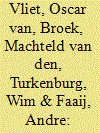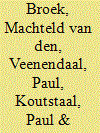|
|
|
Sort Order |
|
|
|
Items / Page
|
|
|
|
|
|
|
| Srl | Item |
| 1 |
ID:
101398


|
|
|
|
|
| Publication |
2011.
|
| Summary/Abstract |
We examined the co-evolution of the transportation, and electricity and heat generation sectors in the Netherlands until 2040 using a MARKAL bottom-up cost optimisation model.
All scenario variants investigated indicate a switch away from crude oil-based diesel and petrol for transportation. Lowest overall CO2 abatement cost is achieved by accommodating transportation first and using relatively expensive options for emissions reduction in electricity generation if needed.
Biomass and carbon capture and storage (CCS) are used to full potential. Transportation CO2 emissions are reduced by switching to ethanol or bio-based synthetic fuels combined with CCS, and series hybrid cars if needed. Depending on the availability of biomass and carbon storage capacity, electricity is produced from biomass, coal with CCS, or wind complemented with natural gas. Indirect greenhouse gas emissions rise to 34-54% of national emissions in 2040.
The difference in annual investment required between the scenario variants with and without CO2 emissions reductions of 68% by 2040 is 4-7 billion euro/year, or 0.5-1.2% of projected GDP.
Investment costs are mostly determined by the cost of cars and electricity generation capacity. We observe competition for limited biomass supply and CO2 storage capacity between the transportation and power sectors.
|
|
|
|
|
|
|
|
|
|
|
|
|
|
|
|
| 2 |
ID:
103334


|
|
|
|
|
| Publication |
2011.
|
| Summary/Abstract |
A greenhouse gas emission trading system is considered an important policy measure for the deployment of CCS at large scale. However, more insights are needed whether such a trading system leads to a sufficient high CO2 price and stable investment environment for CCS deployment. To gain more insights, we combined WorldScan, an applied general equilibrium model for global policy analysis, and MARKAL-NL-UU, a techno-economic energy bottom-up model of the Dutch power generation sector and CO2 intensive industry. WorldScan results show that in 2020, CO2 prices may vary between 20 €/tCO2 in a Grand Coalition scenario, in which all countries accept greenhouse gas targets from 2020, to 47 €/tCO2 in an Impasse scenario, in which EU-27 continues its one-sided emission trading system without the possibility to use the Clean Development Mechanism. MARKAL-NL-UU model results show that an emission trading system in combination with uncertainty does not advance the application of CCS in an early stage, the rates at which different CO2 abatement technologies (including CCS) develop are less crucial for introduction of CCS than the CO2 price development, and the combination of biomass (co-)firing and CCS seems an important option to realise deep CO2 emission reductions.
|
|
|
|
|
|
|
|
|
|
|
|
|
|
|
|
|
|
|
|
|